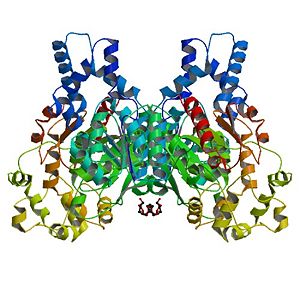Structure
The Human soluble Epoxide hydrolase is a homodimer. Each subunit has , linked by a proline-rich section.
Mechanism
The C-terminal domain is called Cytosolic epoxide hydrolase 2: it catalyzes the trans-addition of water to epoxides in order to product glycols. The is made of five residues. The 3D structure of this active site is maintained by hydrogen bonds, including those created by D496. The two tyrosines (Y383 and Y466) assist the proper positioning of the substrate by polarizing it, thanks to their hydroxyl groups. D335 plays the role of the nucleophilic acid. Finally, H524 plays the role of a base in order to release the final product.
The N-terminal domain is responsible of the Mg2+ dependant hydrolysis of p-nitrophenyl phosphate. Its contains several conserved aspartates in phosphatases and phosphonatases: D9, D11, D184 and D185.
Inhibitors

